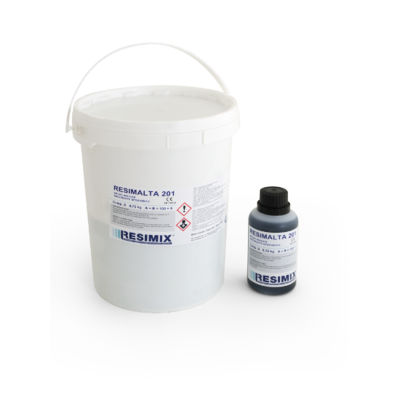RESIMALTA 201
CASTABLE EPOXY MORTAR FOR FIXINGS AND GROUTINGS
High strength, two component pourable epoxy mortar, suitable for bedding, filling joints and cracks in concrete floors, bedding anchor bolts, anchoring railway tracks and re-building cantilevers for bridge cranes. An extremely versatile product with excellent mechanical properties and high strength.
Thanks to its fluid consistency, RESIMALTA 201 can be directly applied on the support without using a
primer. Moreover it perfectly fills the casting volume and ensures excellent sealing.
It resists well to static and dynamic stress and its physical characteristics remain constant throughout the cast thickness thanks to a formulation which prevents sedimentation of inerts.
RESIMALTA 201 also ensures:
- waterproofing;
- fast hardening;
- excellent adhesion to concrete, metal, stone, wood;
- adhesion to damp basements;
- electric insulation;
- ease of use: it come packaged in 2 pre-weighed components to avoid any mistakes during weighing.
| Technical characteristics | U.M. | |||||||||||||
|---|---|---|---|---|---|---|---|---|---|---|---|---|---|---|
| Compression strength EN 12190 | 130 | N/mm2 | ||||||||||||
| Bending strength EN 12190 | 53 | N/mm2 | ||||||||||||
| Elastic modulus | >13000 | N/mm2 | ||||||||||||
| Adhesion to concrete | Concrete failure | |||||||||||||
| Adhesion to steel | >10 | N/mm2 | ||||||||||||
| Glass transition point EN 12614 | ca.48 | °C | ||||||||||||
| Creep EN 1544 | 0,30 mm dopo 1 gg 0,34 mm dopo 3 mesi | |||||||||||||
| Pull out EN 1881 on rod ø16 mm break | 220 | kN | ||||||||||||
| Elongation at 75 kN | 0,24 | mm | ||||||||||||
| Electric resistivity ρ | 1012 | Ω | ||||||||||||
| Density of hardened mortar at 25°C | 2,05 | kg/dm3 | ||||||||||||
| A + B mixture ratio | 100 + 5 | Kg/dm� |
| TIME | RESISTENZA A COMPRESSIONE | |||||||||||||
|---|---|---|---|---|---|---|---|---|---|---|---|---|---|---|
| 15 °C | 25 °C | 35 °C | ||||||||||||
| 4 h | - | - | 20 | N/mm2 | ||||||||||
| 8 h | - | 25 | 60 | N/mm2 | ||||||||||
| 12 h | 10 | 60 | 75 | N/mm2 | ||||||||||
| 24 h | 25 | 80 | 90 | N/mm2 | ||||||||||
| 48 h | 75 | 90 | 105 | N/mm2 | ||||||||||
| 7 gg | 115 | 115 | 115 | N/mm2 |
| ø barra (mm) | 8 | 12 | 16 | 20 | 24 | |||||||||
| ø foro (mm) | 12 | 16 | 20 | 25 | 28 | |||||||||
| profondità foro (mm) | 80 | 120 | 160 | 200 | 240 |
Preparation of the basement
The surface to be treated must be clean, healthy, dry and mortar grout and crumbly part-free. Best adhesion is achieved by roughening it by sandblasting.
Application on metals follows careful preparation of the support: remove oils, fats, varnishes and rust by abrading or sandblasting with white metal (SA2 – SA 3 degree).
Where it is necessary, prepare adequate formwork with hopper feeder and exhaust vent.
To prevent the mortar from adhering to the form, please use a detaching agent of a polyethylene foil.
Preparation of the product
Pour component B into component A and blend at slow speed for 3’ – 5’ using drill with helix/spiral to reduce air inlet as much as possible; during this operation, scrape also the bottom and the sides of the container.
Application
Cast the mortar in the volume to be filled.
Notes
Packages are weight pre-measured out: fully use all components A and B. If you wish to divide the package, products must be weighed by respecting the A+B ratio on the label and must not be weighed out based on the volume.
Three essential rules are valid for all bi-component systems: weigh well, carefully mix bottom and walls, observe times of use.
It’s also possible to add a 20% of quartz sand of 2-3 mm grain size; a higher amount decreases the flow capacity.
By pouring B component into A component, the hardening reaction starts: following mixture the time
available is limited and it depends on the temperature.
| TEMPERATURE | POT LIFE | HARDENING | ||||||||||||
|---|---|---|---|---|---|---|---|---|---|---|---|---|---|---|
| 10 °C | - | 12 hours | ||||||||||||
| 15 °C | 70' | 9 hours | ||||||||||||
| 25 °C | 30' | 7 hours | ||||||||||||
| 35 °C | 15' | 5 hours |
Full hardening is achieved after 7 days.
Approx. 20 kg/m² for a layer 1 cm thick.
Available in 2 kg, 5 kg, 10 kg and 20 kg packages (A + B component).
If stored in its original and sealed package, the products remains unaltered for a year if kept in environments with a temperature between 10 and 30 °C.
- Castings under support plates of bridges, pillars, supports, basements, road joints;
- Fixings and injections under tracks for cranes, carts and precision machinery;
- Fast restoration of concrete floors and chipped joints;
- Grouting of steel rods, tension rods, railings, poles;
- Reconstruction or casting carrying of concrete prefab elements (frames, chipped supports);
- Plugging by clogging holes to pass pipes and tubes;

